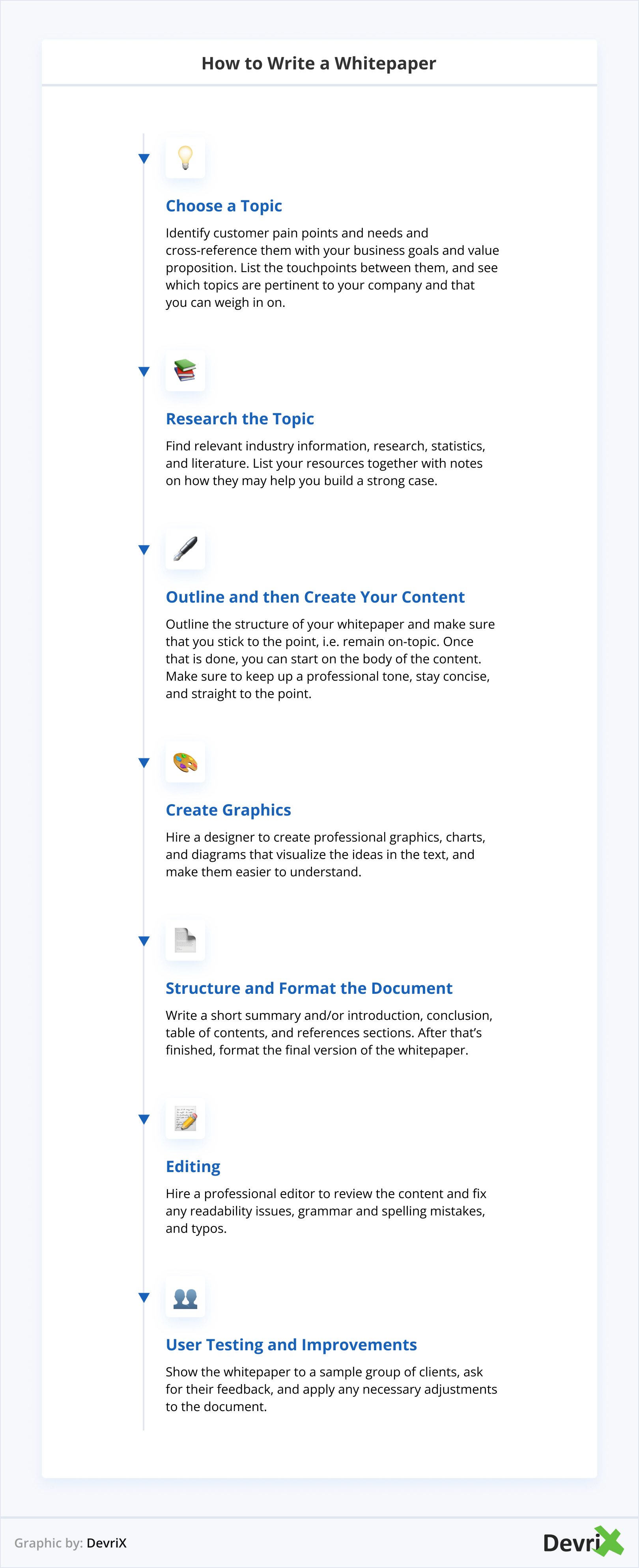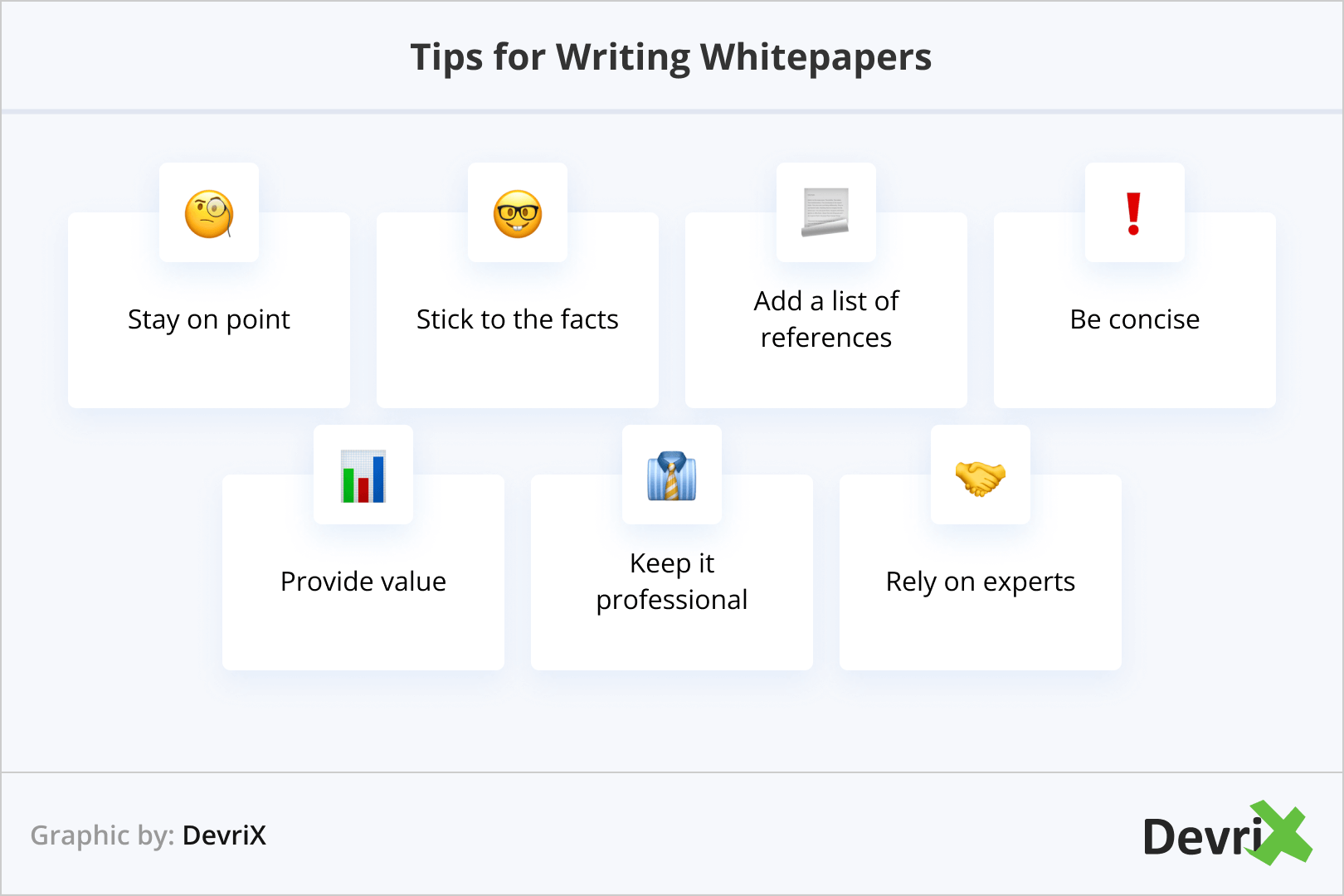When building a content strategy, you should consider creating different types of content that correspond to each stage of the funnel.
More often than not, businesses seem to easily become adept at the more common formats such as blog posts, eBooks, videos, case studies, and podcasts. However, there’s a general misconception about the nature and purpose of whitepapers.
As this is a pivotal type of format when it comes to the bottom half of the content funnel, getting it wrong can compromise a business’s conversions.
In this article, we talk about what whitepapers are and provide a guide on how to create them.
Read on and take notes!
What Is a Whitepaper?
In business, whitepapers are long-form type of content that provides expert information on a subject relevant to the company’s industry, niche, and/or products.
Depending on the subject, a whitepaper can range from 4,000 to 20,000 words, or between 6 to 70 pages.
What differentiates whitepapers from other similar formats such as, for example, case studies, eBooks, and blog posts, is the style, depth, and type of information contained in the content.
Unlike other digital marketing formats, whitepapers require a somewhat academic approach. To that end, the information in them is condensed, to the point that it may be a bit dryer, as compared to other more popular formats.
Furthermore, they are expected to be created by someone who not only has in-depth knowledge of the subject but also the experience, and a holistic understanding of the audience, the industry, and other pertinent topics.
Similar to academic papers, in whitepapers, facts need to be backed up with references to authoritative sources.
Types of Whitepapers
Depending on the topic, there are, generally, two types of whitepapers – product-focused and industry-focused.

Product-Focused
Product-focused types of whitepapers can be used for innovative products to explain the technology and its features by delving into the more technical aspects.
Even if the product is not new, this content type can still be used as a way to provide in-depth information about how it functions, and what makes it different from other solutions on the market.
Whitepapers can also be used as an alternative case study format that provides more details about the process behind a customer success story, and how the company made it happen.
Still, regardless of which approach you choose, keep in mind that whitepapers are not to be used for promotional purposes. As mentioned, the style should be academic and educational, even if it’s your own product that you are talking about.
Industry-Focused
Industry-focused whitepapers delve into topics that are pertinent to the company’s niche and area of expertise.
They can provide information that may be of interest to the audience, find solutions to pain points, or provide other practical applications in the day-to-day lives of the company’s customers.
Although these whitepapers may not directly mention the company’s products and services, they will serve to outline pertinent needs, and highlight issues that the product can, potentially, solve.
For example, a company offering customer relationship management (CRM) software can create a whitepaper demonstrating how lack of consistency in the customer experience across channels can affect retention and revenue.
The business doesn’t need to say “our product solves that”. It needs to show that it understands the problem, can back that up with facts by providing data from different sources, and analyzes the roots of the problem.
What Is the Purpose of Whitepapers?
As mentioned, whitepapers belong in the bottom half of the content funnel. This means that their audience consists of potential customers that are already engaged and interested in the company’s products and services, or researching similar solutions.
As such whitepapers have the following purposes:

- Lead magnet. They can become powerful lead magnets that attract high-quality leads who have the potential to become viable clients.
- Client prospecting asset. Whitepapers can be used in client prospecting and be offered to prominent leads to show off the company’s expertise and the product’s qualities and functionalities.
- Thought-leadership. If the whitepaper is implemented properly and really delivers valuable and meaningful information, it can also contribute to the business’s reputation as a thought leader in the industry.
- Sales booster. Similar to most types of content, the ultimate purpose of whitepapers is to boost the company’s sales.
To do any of these, whitepapers need to be well-written, relevant, and insightful.
How to Write a Whitepaper for Your Business
Regardless of what type of whitepaper you decide to create, there are generally 7 steps to consider:

1. Choose a Topic
The topic of your whitepaper should be relevant to your business and provide a solution to a problem.
To be able to create valuable content, consider listing the most pressing issues your potential customers face. These can be identified by implementing market research, voice of customer research, studying customer support cases, analyzing behavior, and so on.
While it’s easier to focus on the more obvious needs and pain points, consider choosing a hidden issue that your customers may not even be aware of yet.
The goal, of course, is not to make up problems and provide imaginary solutions, but to raise awareness.
Once you have the list of possible pain points, cross-reference them with your business goals and value proposition.
The touchpoints between them will help you brainstorm ideas on how to use your knowledge and expertise, as well as the industry intel at your disposal, to provide specialized information that will help your customers fix their problems.
2. Research the Topic
The information you provide in your whitepaper has to be based not only on your knowledge and experience but on solid facts.
Once you pick a topic, you should research industry-relevant studies, books, publications, scientific papers, and anything else that may help you with your paper and that boosts your credibility.
Such sources will also help you to better understand your idea, and steer the direction of your whitepaper.
Also, by referencing reputable information, your content will seem more valuable, and provide the reader a sense of security because you will seem more trustworthy.
3. Outline and Then Create Your Content
When writing a whitepaper, start with outlining the structure of your text and summarizing what each section will focus on.
This will help you to stay on point instead of straying from the main topic.
Once the idea is clearly outlined, you can get down to the actual writing and expand on each of the sections.
4. Create Graphics
If the topic calls for it, you should consider providing charts and graphics that visualize the information.
As whitepapers provide condensed and, more often than not, highly technical information, graphics can really boost the value of the content and help the reader better understand the topic.
To ensure the quality of the visuals, it’s advisable to hire a professional graphic designer to implement them.
5. Structure and Format the Document
Being more of an academic type of paper, rather than digital marketing content, whitepapers require a specific structure.
In order to be sure that you have all the information you need, it’s best to implement the formatting once you’re ready with the main content.
A whitepaper structure includes the following elements:
- A title page. The first page includes the title of the paper, the name of the company, and the writer/s.
- Table of contents. As the name suggests, here, you should list all the sections of the content and the corresponding pages where the reader can find them.
- Summary. Depending on your preferences, you can start with a summary of the goals of the paper, and the most important highlights and insights that it covers. This can hook the reader, and help them better understand and navigate the content.
- Introduction. In this section, you should introduce the reader to the issue, and the methodologies used in the paper (if any).
- Body. This is the main part of the whitepaper. It should include all the information you want to convey to the reader. This includes the problem (the pain point or need), what causes it and why, what can aggravate it, and possible solutions.
- Dictionary of terms. If you are using complicated terminology in your content, you should consider adding a dictionary or explanatory footnotes, that will help the reader better understand what you are talking about. This way, you will retain their attention, and keep them from leaving the document to google complex terms.
- Conclusion. This section should feature the key takeaways from the whitepaper.
- References. A list of resources, studies, research, statistics, and literature used in writing the whitepaper.
6. Editing
Editing should take place twice during the writing process.
The first time should be when you are ready with the body of the text, and the second, once you have all the content written and structured together with the graphics and all the pertinent information.
This way, you will ensure that there are no spelling and grammatical mistakes and that no accidental typos or other issues occur during the formatting.
To increase the quality of your work you should have a professional editor review it.
7. User Testing and Improvements
Once the final product is ready, you should consider showing it to a sample of potential clients. Ask for their feedback, opinion, and suggestions.
This way, you will ensure that the whitepaper provides value and will properly serve its purpose.
Tips for Writing Whitepapers
Here are a few practical tips to follow when writing a whitepaper for your business:

- Stay on point. Abstain from adding unnecessary information that doesn’t contribute to the overall value of the content, and/or strays from the topic.
- Stick to the facts. Avoid assumptions and/or theories that you are unable to prove, and provide only information that can be verified and validated.
- Add a list of references. Provide a list of resources you used in your research, including documentation, papers, books, studies, etc. If you are using your own research, provide links to it as well.
- Be concise. You need to be concise and restrain yourself from adding fluff, using metaphors, adjectives, stories, and so on. While these are popular in blogging and other formats, they have no place in a whitepaper.
- Provide value. The information you provide should convince the reader of your expertise. Also, it needs to show (or hint) that your business is the partner they need to make their life better.
- Keep it professional. Whitepapers are serious documents, and they should live up to the expectations of the reader. Keep up the professional tone, structure the content well, and make sure to provide high-quality graphics.
- Rely on experts. While business and marketing content is created by marketers, whitepapers have to be written by subject matter experts. Otherwise, they may not have the same value.
Bottom Line
When it comes to digital marketing content types, whitepapers are as complex as they come.
They require in-depth knowledge of the subject at hand, an academic approach, and a to-the-point attitude.
Furthermore, creating them takes much longer than other common content formats across the funnel.
However, they can bring in the highest quality of leads, and contribute to the company’s conversions and revenue. Therefore, they are definately worth all the effort.




